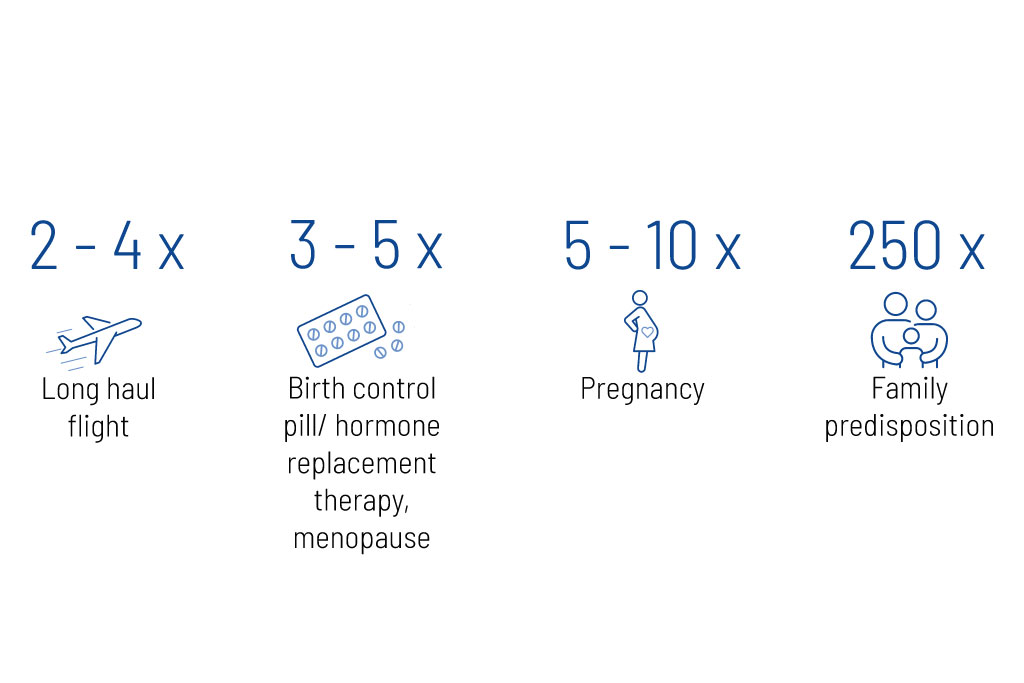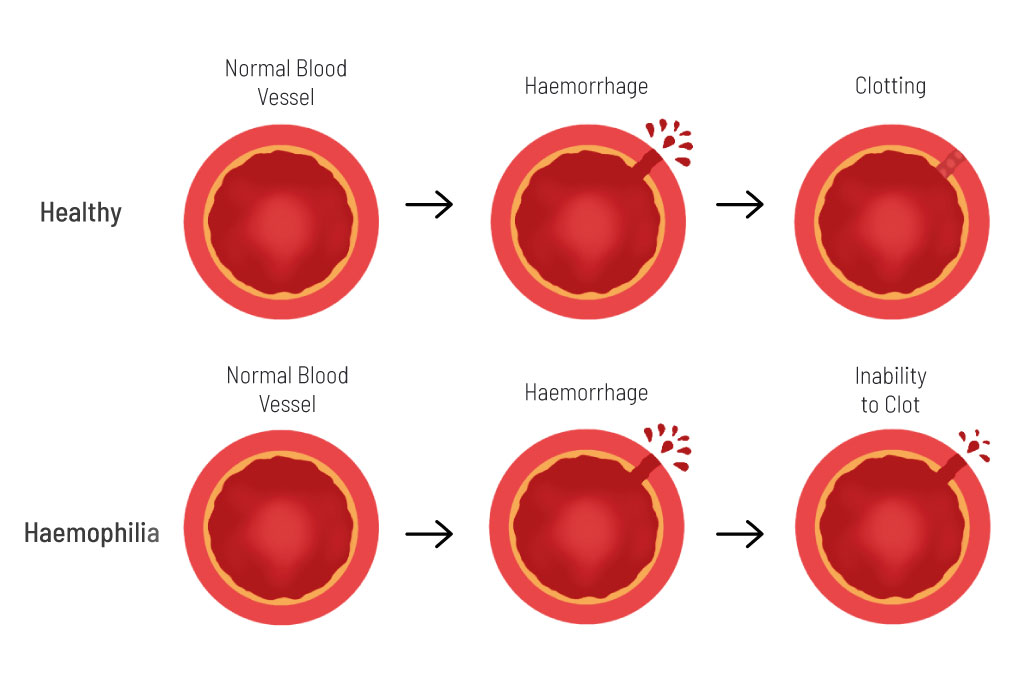Hereditary disorders of blood clotting can lead to thromboses (blood clots in vessels), which can cause strokes, for example. Therefore, hereditary forms of thrombosis increase the risk of leg vein thromboses, strokes, pulmonary embolisms, and miscarriages, among others. A familial predisposition is associated with a much more pronounced elevation in risk compared to other causes such as pregnancy (figure 1). Another form of impaired coagulation is hemophilia (bleeding tendency). Due to a genetic defect, blood clotting can be slowed down, which can cause increased bleeding. If the individual risk is known, appropriate measures can help to reduce this risk.
Are you insured in Germany? Our colleagues at the Zentrum für Humangenetik Tübingen will gladly support you!
Figure 1: Factors that increase the likelihood of developing thrombosis.1
What Are Thrombosis and Coagulation Disorders?
Blood coagulation is an important ability of our body to protect us from heavy blood losses. E.g. if we have an injury, this wound can timely be closed by intact blood coagulation.
In the event of damage at the wall of a blood vessel, blood clotting is activated. Thrombocytes (blood platelets) accumulate at the defect site. A cascade of reactions is triggered that leads to the crosslinking of fibrins (proteins) and platelets and lastly leads to the closing of the wound.
However, a disruption of the coagulation processes can lead to increased or reduced blood clotting. Increased coagulation can cause thrombi (blood clots) to form in the blood vessels, which can lead to partial or complete vascular occlusion (figure 2). If such a blood clot forms e.g., in the leg, this is referred to as a leg vein thrombosis. Parts of this clot can also break off and be washed into other organs via the bloodstream. If a thrombus settles in the brain, it is called a stroke.
A corresponding genetic predisposition can significantly increase the risk of thrombosis and therefore also of various consequences such as pulmonary embolisms, heart attacks, strokes, and miscarriages.
In contrast, genetic variants can also lead to reduced blood coagulation, which is called hemophilia (bleeding tendency). Here, the function of the blood clotting factors may be impaired due to a genetic defect. As a result, hemostasis takes too long or does not work at all (figure 2). Already smaller lesions or interventions can lead to extensive bleeding in tissues and joints as well as to relevant blood losses. The knowledge of such tendencies can be extremely relevant e.g., during surgery.
Field Report
Martina S., 42 years old
Lifestyle: sedentary office work, little exercise
Result: Our preventive diagnostics identified an increased risk of thrombosis in Martina S. due to a variant in the PROC gene.
Consequence: Martina S. generally pays attention to a healthy lifestyle and tries to get more exercise. If she is without exercise for a longer period of time, e.g. on a long car journey or after an operation, she discusses the need for additional preventive measures with her internist to prevent thrombosis.
“I’m glad I did the test. Now I know that I have an increased risk of thrombosis and how I can counteract this in everyday life and when traveling.”
How Does Genetic Risk Assessment Work?
We can help you to determine your genetic risk of thrombosis and coagulation disorders. To do this, we use next-generation sequencing, a comprehensive method for the precise reading of genetic information. Based on the results of the analysis, potential increased disease risks can be determined.
If the genetic risk is increased, various preventive and precautionary measures may be advisable. To prevent thrombosis, a change in lifestyle by e.g. avoiding alcohol and tobacco products, drinking enough fluids, wearing compression stockings and exercise can help. If necessary, medication can also be supportive.
In the module Thrombosis and Coagulation Disorders, we analyze twenty-eight genes that are associated with hereditary thrombosis and coagulation disorders. If certain genetic risk factors are found in time, the treating physician can arrange preventive and precautionary measures accordingly.
You Are also Welcome to Take a Look at the Following Areas
Contact Us
Do you have a question, or are you interested in our service?
Diagnostic Support
We will assist you in selecting the diagnostic strategy – whether as a person seeking advice or as a physician.

References
1 Robert Koch Institut, GBE, Heft 44, “Venenerkrankungen”, 2009.






